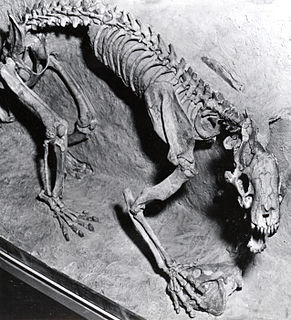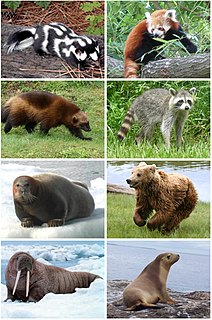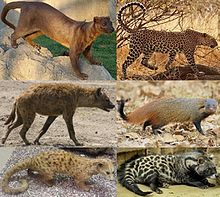
Carnivora is an order of placental mammals that have specialized in primarily eating flesh. Its members are formally referred to as carnivorans, though some species are omnivorous, such as raccoons and bears, and very few species such as pandas are specialized herbivores. The word carnivore is derived from Latin carō 'flesh' and vorāre 'to devour', and refers to any meat-eating organism. The order Carnivora is the fifth largest order of mammals and one of the more successful members of the group, as it comprises at least 279 species.

Vertebrate paleontology is the subfield of paleontology that seeks to discover, through the study of fossilized remains, the behavior, reproduction and appearance of extinct animals with vertebrae or a notochord. It also tries to connect, by using the evolutionary timeline, the animals of the past and their modern-day relatives.

Tylopoda is a suborder of terrestrial herbivorous even-toed ungulates belonging to the order Artiodactyla. They are found in the wild in their native ranges of South America and Asia, while Australian feral camels are introduced. The group has a long fossil history in North America and Eurasia. Tylopoda appeared during the Eocene around 46.2 million years ago.

Nimravidae is an extinct family of carnivorans, sometimes known as false saber-toothed cats, whose fossils are found in North America and Eurasia. Not considered to belong to the true cats, the nimravids are generally considered closely related and classified as a distinct family in the suborder Feliformia. Fossils have been dated from the Middle Eocene through the Late Miocene epochs, spanning about 33.2 million years.

Miacis is a genus of extinct carnivorous mammals that appeared in the late Paleocene and continued through the Eocene. The genus Miacis is not monophyletic but a diverse collection of species that belong to the stemgroup within the Carnivoramorpha. As such, most Miacis species belong to the group of early carnivores that represent the ancestors of the modern order, the crown-group Carnivora. However, the species Miacis cognitus is placed not in the stem-group but among the Caniformia, one of the two suborders of the crown-group Carnivora.
Herbstosaurus is the name given to a genus of pterosaurs that lived during the Late Jurassic period, in what is now Argentina. In 1969 Argentine paleobotanist Rafael Herbst in the province Neuquén at Picun Leufú dug up a piece of sandstone holding a number of disarticulated bones of a small reptile. At the time it was assumed the rock dated to the Middle Jurassic (Callovian), about 163 million years ago.

Barbourofelidae is an extinct family of carnivorans of the suborder Feliformia that lived in North America, Eurasia and Africa during the Miocene epoch and existed for about 7.9 million years.

Carnivoramorpha ("carnivora-shaped") is a clade of placental mammals that includes the modern order Carnivora and its extinct stem-relatives.

Feliformia is a suborder within the order Carnivora consisting of "cat-like" carnivorans, including cats, hyenas, mongooses, viverrids, and related taxa. Feliformia stands in contrast to the other suborder of Carnivora, Caniformia.
Paleontology or palaeontology is the study of prehistoric life forms on Earth through the examination of plant and animal fossils. This includes the study of body fossils, tracks (ichnites), burrows, cast-off parts, fossilised feces (coprolites), palynomorphs and chemical residues. Because humans have encountered fossils for millennia, paleontology has a long history both before and after becoming formalized as a science. This article records significant discoveries and events related to paleontology that occurred or were published in the year 1921.
Acherontemys is an extinct genus of turtle from Miocene of United States.
Herpestides is an extinct genus of terrestrial carnivore that was endemic to North Africa and Southern Europe during the Early Miocene subepoch and existed for approximately 2.4 million years.

Protocyon is an extinct genus of large canid endemic to South and North America during the Late Pleistocene living from 781 to 12 thousand years ago.

Arctoidea is a clade of mostly carnivorous mammals which include the extinct Hemicyonidae (dog-bears), and the extant Musteloidea, Pinnipedia, and Ursidae (bears), found in all continents from the Eocene, 46 million years ago, to the present. Arctoids are caniforms, along with dogs (canids) and extinct bear dogs (Amphicyonidae). The earliest caniforms were superficially similar to martens, which are tree-dwelling mustelids. Together with feliforms, caniforms comprise the order Carnivora, sometimes Arctoidea can be considered a separate suborder from Caniformia and a sister taxon to Feliformia.
Africanictis is an extinct genus of carnivorous cat-like mammals belonging to the superfamily Aeluroidea, endemic to Africa for approximately 11.42 million years, from 23.03 to 11.610 Ma, during the Miocene epoch.
Asiavorator is an extinct genus of carnivorous, cat-like civet endemic to Asia in the Oligocene.
Moghradictis is an extinct genus of carnivorous cat-like mammals belonging to the superfamily Aeluroidea, endemic to North Africa during the Early Miocene.

Stenoplesictis is an extinct genus of carnivorous cat-like mammals belonging to the superfamily Aeluroidea, from Europe and Asia (Mongolia), from the Oligocene 33.9—28.4 Ma, existing for about 5.5 million years.

Xiphodontidae is an extinct family of even-toed ungulates, endemic to Europe during the Eocene 40.4—33.9 million years ago, existing for about 7.5 million years. They were, most likely, all terrestrial herbivores. Paraxiphodon suggests that they survived into the Lower Oligocene, at least.

Carnivoraformes ("carnivora-shaped") is a clade of placental mammals that includes the modern order Carnivora and its extinct stem-relatives.












